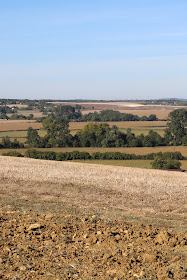On our latest hike, The Calm One and I returned to the area from last week's walk, but ventured a bit further south. A nearby road had a deer crossing sign, and sure enough as we headed into the forested pathway, there was a deer, in the near distance, making a beeline for that designated spot! The path was flanked with barbed wire most likely to keep people out and deer in. It will be official hunting season until the end of September and our walk was punctuated with sudden, muffled pops. Muffled is good, we both thought as we made sure we stayed on the path.
Leaving the forest behind, we approached a harvested field. It is also mushroom hunting season so it was not entirely silly of me to think this was a dehydrated boletus ravaged by animals who got to it first before any humans.
When I saw another specimen, I started slowly to doubt my initial identification.
Wild chicory abounds in our area and a beauty caught my attention for a while. But like any nature aficionado, I continued to ruminate about what could that boletus be if it wasn't a boletus?
Then by the time I saw yet another 'dried-out boletus', I put everything together and realised it was a sunflower head. Sunflowers, along with grapes and grains, are common crops in these parts.
The nearby field was a recently harvested sunflower crop. The desiccated nature of the flower head probably was due to the agricultural practice of using drying chemicals to facilitate threshing. Some missed seeds can be noted near the upper right corner in the above photo.
With the patch of farmland receding behind us, we re-entered the forest.
Shortly afterward, we encountered a sizable expanse of purple-pink heather.
Most heathers insist on acidic soil, so it is reasonable to conclude that the pH of the soil is low.
The next prominent flora was fern after fern after fern. Some were green and others were bronzed. Since ferns love their shade, the ones with the deep tan were in full sunlight. Being immobile and having no access to sunscreen lotion, they were showing stress. Or a happier possible explanation is that, they were deciduous and were beginning to prepare for winter.
À la prochaine!
Leaving the forest behind, we approached a harvested field. It is also mushroom hunting season so it was not entirely silly of me to think this was a dehydrated boletus ravaged by animals who got to it first before any humans.
When I saw another specimen, I started slowly to doubt my initial identification.
Wild chicory abounds in our area and a beauty caught my attention for a while. But like any nature aficionado, I continued to ruminate about what could that boletus be if it wasn't a boletus?
Then by the time I saw yet another 'dried-out boletus', I put everything together and realised it was a sunflower head. Sunflowers, along with grapes and grains, are common crops in these parts.
The nearby field was a recently harvested sunflower crop. The desiccated nature of the flower head probably was due to the agricultural practice of using drying chemicals to facilitate threshing. Some missed seeds can be noted near the upper right corner in the above photo.
With the patch of farmland receding behind us, we re-entered the forest.
Shortly afterward, we encountered a sizable expanse of purple-pink heather.
Most heathers insist on acidic soil, so it is reasonable to conclude that the pH of the soil is low.
The next prominent flora was fern after fern after fern. Some were green and others were bronzed. Since ferns love their shade, the ones with the deep tan were in full sunlight. Being immobile and having no access to sunscreen lotion, they were showing stress. Or a happier possible explanation is that, they were deciduous and were beginning to prepare for winter.
À la prochaine!









